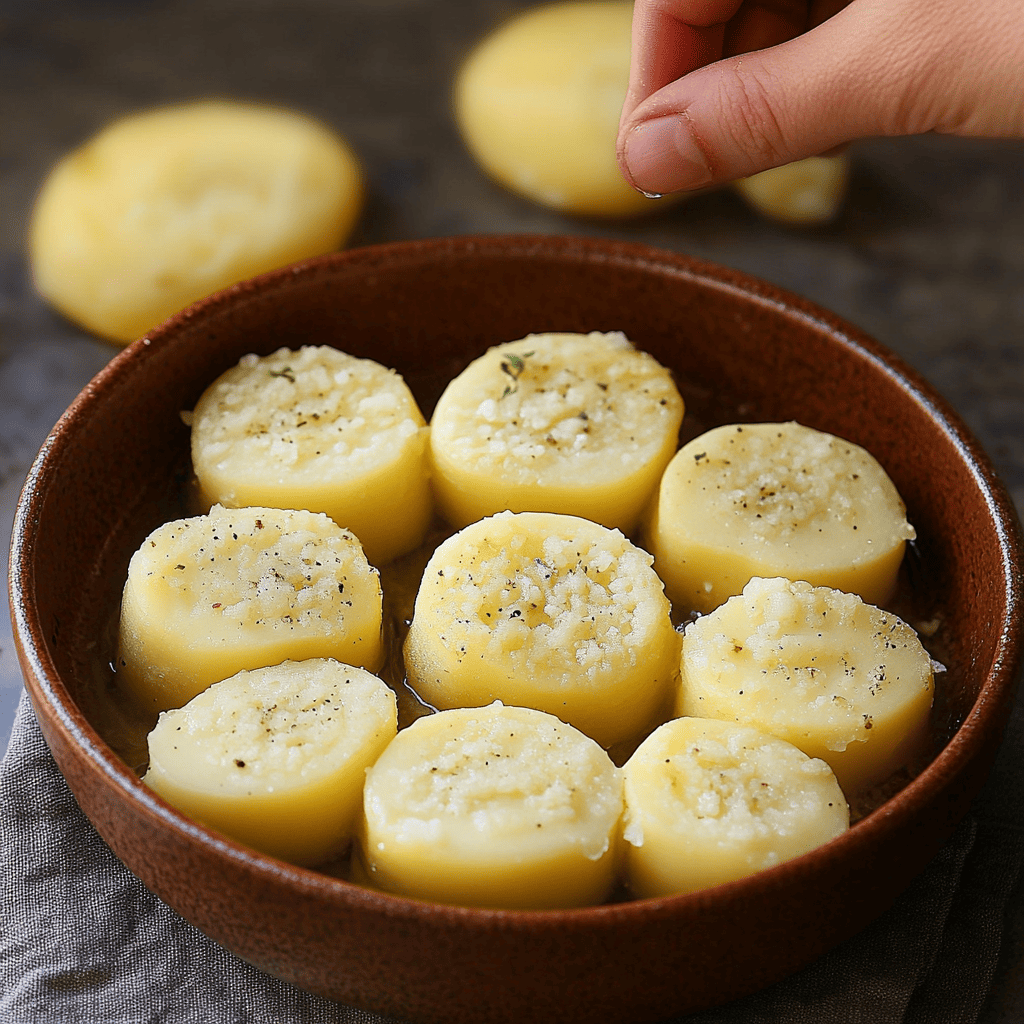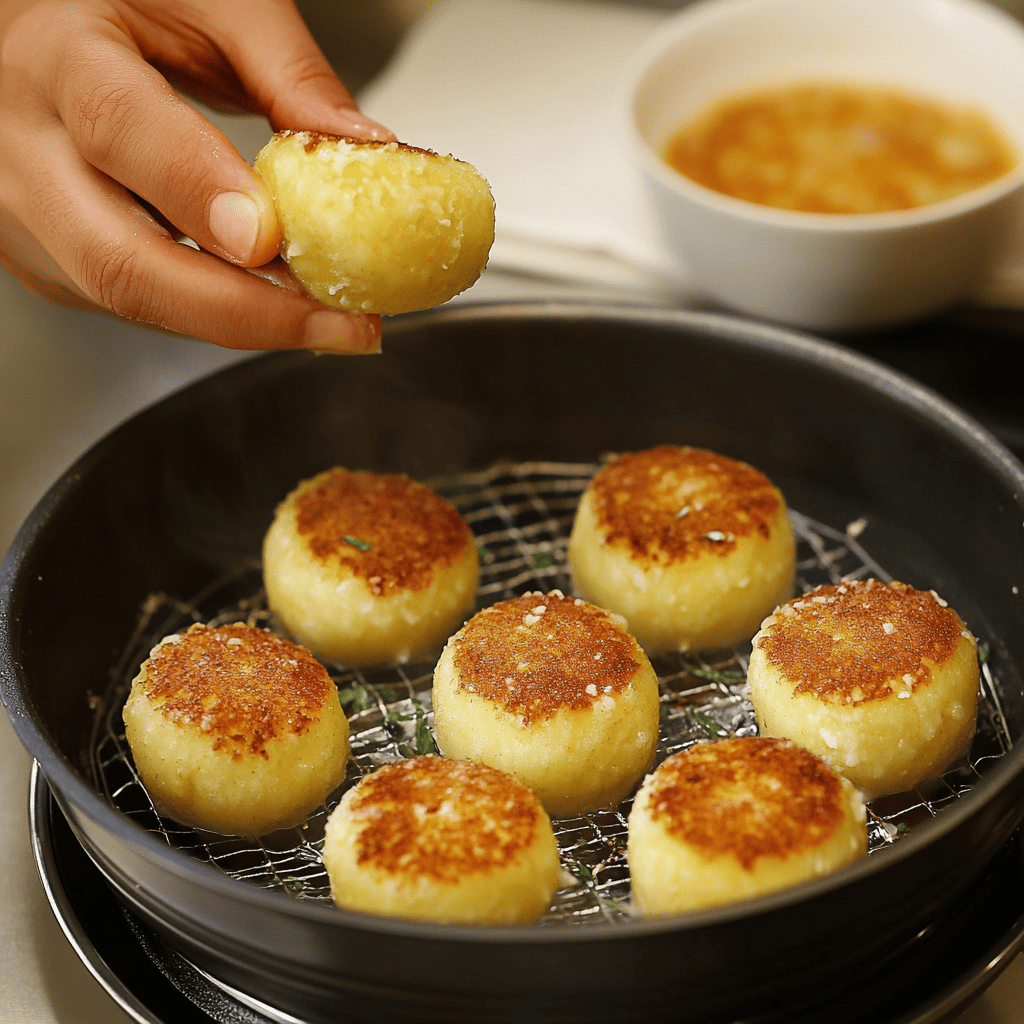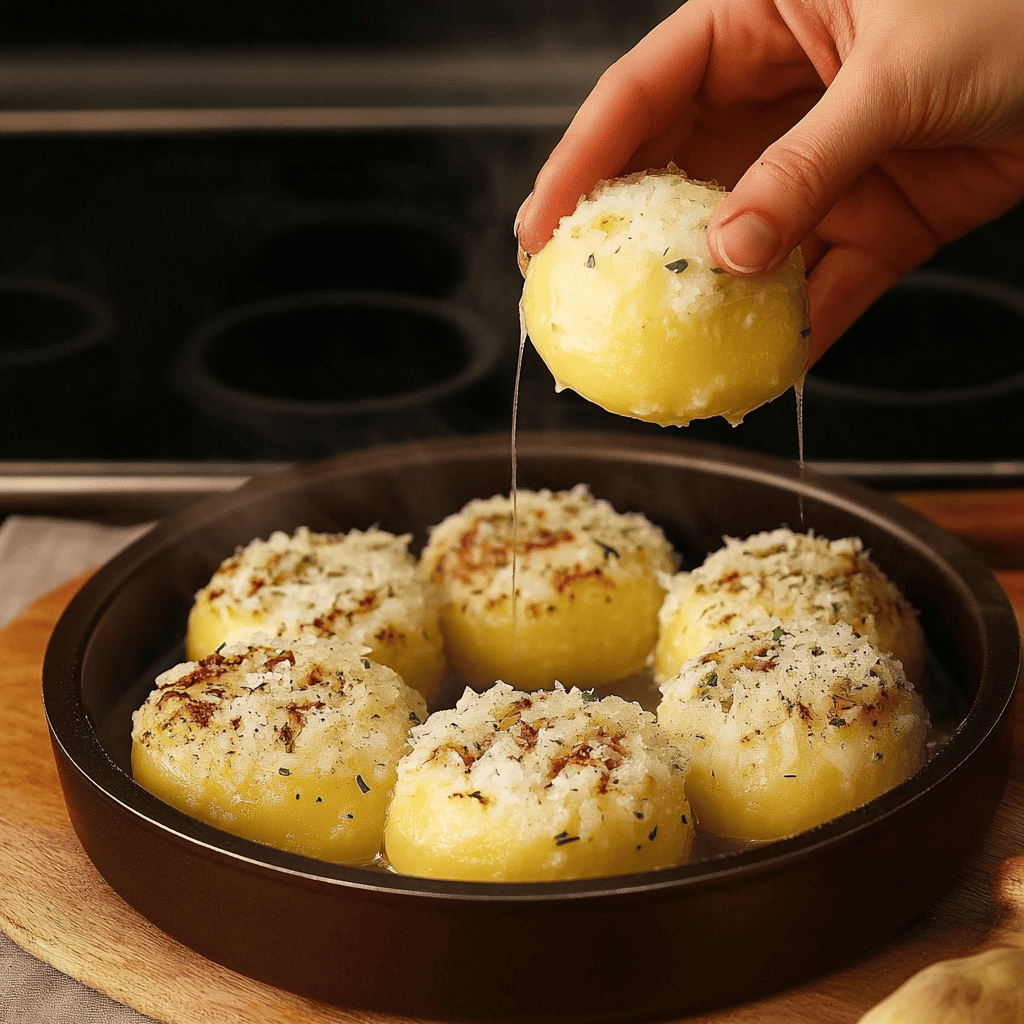Stuffed Mashed Potato Nests: The Ultimate Recipe for an Irresistibly Homemade Dish
Stuffed Mashed Potato Nests are one of those culinary gems that combine the simplicity of everyday ingredients with an elegant presentation and a soul-warming flavor. Perfect for a family meal, a special dinner, or just a treat, this dish transforms humble mashed potatoes and savory ground beef into an edible work of art. In this article, we’ll guide you step-by-step through creating these golden and delicious nests, explore their history, their variations, and give you all the tricks to make them perfect. Get ready to fall in love with this recipe!
Introduction: A Hug in the Form of Food
Imagine a smooth and creamy base of mashed potatoes, enriched with butter and hints of fresh dill, baked to a perfect golden brown. Now, visualize that mashed potato forming little nests, each cradling a juicy and aromatic filling of ground beef seasoned with spices, vegetables, and a hint of parsley. To top it all off, a layer of melted, bubbling mozzarella cheese seals in all the flavors. Is your mouth watering? These are Stuffed Mashed Potato Nests.
More than just a recipe, this dish is an experience. It’s the combination of textures—the smoothness of the mashed potatoes, the tenderness of the meat, the elasticity of the cheese—and the explosion of flavors that make it an instant favorite. Plus, its versatility allows it to be adapted to different tastes and occasions, making it an ace up any cook’s sleeve. Join us on this culinary journey and discover why Stuffed Mashed Potato Nests deserve a place of honor in your recipe book.
Detailed History: The Legacy of the Potato and Creativity in the Kitchen
While “Stuffed Mashed Potato Nests” as we know them today are a relatively modern creation, their roots lie deep in the culinary history of their main components: potatoes and minced meat preparations.
The Triumphal Journey of the Potato
The potato , native to the Andean region of South America (primarily Peru and Bolivia), was first cultivated around 7,000 to 10,000 years ago. For the Inca and pre-Inca civilizations, the potato was not just a food, but a cultural and economic pillar. Its ability to grow at high altitudes and in harsh climatic conditions made it a vital source of food.
With the arrival of the Spanish conquistadors in the 16th century, the potato began its journey to Europe. Initially, it was greeted with skepticism and even fear. It was considered exotic, and some associated it with diseases due to its belonging to the Solanaceae family (like belladonna). However, its nutritional value and adaptability soon overcame these prejudices. Figures such as Antoine-Augustin Parmentier in France played a crucial role in popularizing it during the 18th century, demonstrating its virtues and promoting its cultivation to combat famine.
Mashed potatoes , as a preparation, emerged as a logical and delicious way to consume this tuber. The technique of boiling and mashing potatoes, adding dairy products such as milk, cream, or butter to enrich their flavor and texture, spread throughout Europe and, later, the world. It became the quintessential side dish, the perfect accompaniment to meats and stews.
The Tradition of Stuffing and Gratinating
The idea of stuffing food is ancient and universal. From hollowed-out vegetables (peppers, tomatoes, zucchini) to doughs (empanadas, pastries), humanity has always found creative ways to combine ingredients and textures.
On the other hand, ground or minced meat has been an efficient and tasty way to use less tender cuts of meat. Stews, meatballs, sauces like Bolognese, and meatloaf fillings are examples of its versatility. Dishes like the British Shepherd’s Pie or Cottage Pie (with beef instead of lamb), which consist of a layer of stewed minced meat covered with mashed potatoes and baked, are clear conceptual precursors to our nests. These preparations, born from the need to economize and make the most of ingredients, became classics of “comfort food.”
Gratin , the technique of coating a dish with cheese or breadcrumbs and butter and then baking it until golden and crispy, adds another dimension of flavor and texture. Melted, lightly toasted cheese is, for many, synonymous with indulgence and satisfaction .
More Detailed History: The Convergence Towards the “Nest”
Stuffed Mashed Potato Nests represent an aesthetic and practical evolution of these traditions. There is no single inventor or exact date for their creation, but rather a convergence of influences and a search for more attractive presentations and individual portions.
- Influence of Duchess Potatoes (Pommes Duchesse): This classic French dish consists of mashed potatoes enriched with egg yolk and butter, which are piped into decorative shapes (often rosettes or spirals) and baked until golden brown. The idea of shaping and baking mashed potatoes is a direct precursor.
- Evolution of Potato Pie/Shepherd’s Pie: While potato pie is prepared in a large dish, the idea of individualizing and making the portions more attractive led to experimentation with shapes. The “nest” or “volcano” of mashed potatoes is an ingenious way to contain the filling and create a visually striking dish.
- Creativity in Home and Restaurant Cooking: With the rise of cooking blogs, culinary television shows, and social media platforms like Instagram and Pinterest, there has been an explosion of creativity in presenting homemade dishes. Amateur and professional cooks are constantly looking for new ways to surprise and delight. Mashed Potato Nests fit perfectly into this trend: they are relatively easy to make, use accessible ingredients, and the result is very photogenic.
- Cultural Adaptation: While the base of mashed potatoes and meat is common in many cultures, the specific seasonings for the filling can vary greatly, reflecting local tastes. In Latin America, for example, it is common to use sofritos with onion, garlic, bell pepper, and tomato, as well as fresh herbs like cilantro or parsley, and spices like cumin or paprika.
Thus, Stuffed Mashed Potato Nests are not so much a dish with a linear and documented history, but rather the result of a culinary evolution, where proven techniques and beloved ingredients are combined in a novel and appealing way, responding to the human desire to enjoy meals that are not only tasty but also a pleasure to the eye. They are a testament to how home cooking can be innovative and sophisticated without losing its comforting essence.

Ingredients ( )
To prepare approximately 6-8 nests, you will need:
For the Mashed Potatoes:
- 3 to 5 large potatoes (about 1 kg), preferably floury (Russet, King Edward, or the local variety recommended for mashing)
- 3 1/2 tablespoons (50 g) unsalted butter, at room temperature
- ¼ – ½ cup warm milk or cream (optional, for extra creaminess)
- 1 egg yolk (optional, for structure and color)
- 1 bunch of fresh dill, finely chopped (or 1 tablespoon of dried dill)
- Salt to taste
- Freshly ground black pepper to taste
For the Ground Beef Filling:
- 500g ground beef (or a mix of beef and pork)
- 1 medium onion, finely chopped
- 2 cloves garlic, finely chopped or pressed
- 1 medium red bell pepper, finely chopped
- 1 large, ripe tomato, peeled and diced (or ½ cup canned crushed tomatoes)
- 70 g (about 3-4 tablespoons) of tomato paste or tomato concentrate
- 1 bunch of fresh parsley, finely chopped
- 1 teaspoon smoked paprika
- ½ teaspoon dried oregano
- Salt to taste
- Freshly ground black pepper to taste
- A splash of red wine or beef broth (optional, for more flavor)
- 1-2 tablespoons of olive oil
For the Final Touch:
- 100-150g grated mozzarella cheese (or another cheese that melts well, such as cheddar, provolone, or a blend)
Detailed Preparation
Follow these steps to ensure perfect nests:
Step 1: Making the Perfect Mashed Potatoes
- Wash and Cook the Potatoes: Peel the potatoes and cut them into medium-sized, uniform chunks. This ensures even cooking. Place them in a large pot and cover with cold water. Add a generous teaspoon of salt to the water. Bring to a boil and then reduce the heat to medium-low. Simmer until the potatoes are very tender and can be easily pierced with a fork (approximately 15-25 minutes, depending on the size of the chunks).
- Drain and Dry: Once cooked, drain the potatoes well in a colander. Return them to the hot pot (off the heat) for a minute or two to allow any excess moisture to evaporate. This is key for a thinner, less watery mash.
- Make the Mash: Pass the potatoes through a food mill or mash them directly in the pot. If you don’t have a food mill, you can use a potato masher. Avoid using an electric mixer or food processor, as this can develop starch and make the mash gummy.
- Enrich the Puree: Add the cubed butter, the egg yolk (if using), the chopped dill, and salt and pepper to taste. Begin mixing gently with a wooden spoon or spatula. If you want a creamier texture, add the warm milk or cream gradually, mixing until you reach the desired consistency. Taste and adjust the seasoning if necessary. The puree should be firm but malleable. Let it cool slightly to make it easier to handle.
Step 2: Make the Tasty Ground Beef Filling
- Sauté the Aromatics: Heat the olive oil in a large skillet or cauldron over medium heat. Add the chopped onion and sauté until translucent and soft (about 5-7 minutes).
- Add Garlic and Pepper: Add the minced garlic and red pepper. Cook for another 3-5 minutes, stirring occasionally, until the pepper begins to soften.
- Brown the Meat: Increase the heat to medium-high and add the ground beef to the skillet. Break up the meat with a wooden spoon and cook until it’s completely browned and no pink remains. Drain any excess fat if necessary.
- Add Flavor: Add the chopped (or crushed) tomatoes and tomato paste. Stir well to combine. Cook for a few minutes to allow the flavors to blend and the tomato to cook slightly.
- Season: Add the smoked paprika, dried oregano, and salt and pepper to taste. If using red wine or broth, add it now and let it reduce slightly.
- Simmer: Reduce heat to low, cover the pan, and let it simmer for at least 15-20 minutes (or longer if you have time) to allow all the flavors to blend and the sauce to thicken slightly.
- Final Touch of Freshness: Remove from heat and add the chopped fresh parsley. Mix well and taste to adjust the seasoning one last time. The filling should be juicy but not overly runny.
Phase 3: Assemble and Bake the Nests
- Preheat the Oven: Preheat your oven to 200°C (400°F). Prepare a baking sheet by lining it with baking paper (parchment paper) or lightly greasing it.
- Forming the Nests: There are several ways to do this:
- By Hand: Take a generous portion of mashed potatoes (about 1/2–3/4 cup, depending on the desired size) and form it into a ball. Then, with your fingers, create an indentation in the center, like a nest or a small bowl, making sure the walls are thick enough to hold the filling. Place the nest on the prepared baking sheet.
- Using a Pastry Bag: If the puree is firm enough, you can use a pastry bag with a large nozzle (plain or star) to form a base circle and then build the walls of the nest in a spiral upwards.
- Using a Cup/Mold: You can lightly grease the outside of a small cup and press a ball of mash into it to form the cavity.
- Fill the Nests: Using a spoon, generously fill each mashed potato nest with the ground beef mixture.
- Top with Cheese: Sprinkle grated mozzarella cheese generously over the meat filling in each nest.
- Bake: Place the tray in the preheated oven and bake for 15-20 minutes, or until the mashed potatoes are lightly browned around the edges, the cheese is completely melted, bubbly, and has some golden brown spots.
- Gratin (Optional): If you want a deeper browning of the cheese, you can turn on the oven’s grill (broiler) for the last 1-2 minutes. Watch closely to prevent burning.
- Rest and Serve: Remove the nests from the oven and let them rest for 5-10 minutes before serving. This helps them set and prevents burning from the hot filling. Garnish with more chopped fresh parsley or dill if desired.
Estimated Preparation Time
- Preparing ingredients (chopping vegetables, etc.): 20-30 minutes
- Cooking potatoes: 15-25 minutes
- Preparation of the puree: 10 minutes
- Cooking time of the meat filling: 30-40 minutes
- Nest assembly: 15-20 minutes
- Baking: 15-20 minutes
Estimated Total Time: Approximately 1 hour 45 minutes to 2 hours 25 minutes (may vary depending on skill level and if tasks are performed in parallel).
Additional Tips for Success
- Potato Type: Use starchy potatoes such as Russet, Idaho, King Edward, or Monalisa. These potatoes have less moisture and produce a lighter, fluffier mash, ideal for maintaining the shape of the nests.
- Don’t Overmix the Puree: Blend the puree only until the ingredients are combined. Overmixing can release too much starch and make it gummy.
- Cool the Puree: Letting the puree cool slightly before forming the nests makes it easier to handle. If it’s too warm, it will be sticky and difficult to shape.
- Flavor of the Puree: Don’t underestimate the seasoning of the puree. A well-seasoned puree is the foundation of the dish. Taste and adjust the salt and pepper. Consider adding a touch of grated nutmeg for a classic flavor.
- Juicy, Not Soggy Filling: Make sure the meat filling is juicy but not overly liquid, as this could make the puree too wet. If your filling seems too runny, cook it uncovered for a few more minutes to allow the excess moisture to evaporate.
- Cheese Variations: Feel free to experiment with different cheeses. A sharp cheddar, a smoked provolone, or even a blend of cheeses like four cheese can add interesting nuances.
- Advance Preparation:
- The meat filling can be prepared one or two days in advance and stored in the refrigerator. It even enhances its flavor.
- The mashed potatoes can also be made in advance, although they’re best when fresh. If you make them ahead of time, store them tightly covered in the refrigerator. You may need to warm them slightly and add a little more milk or butter to make them creamier before forming the nests.
- You can assemble the nests a few hours before baking, cover them, and refrigerate them. Add a few extra minutes to the baking time if you bake them from cold.
- Freezing: Baked nests can be frozen. Let them cool completely, then wrap them individually in plastic wrap and then aluminum foil, or place them in a freezer-safe container. To reheat, thaw in the refrigerator and then heat in the oven at 180°C (350°F) until piping hot. The texture of the puree may change slightly after freezing.

Frequently Asked Questions (FAQ)
Q: Can I make a vegetarian version of Mashed Potato Nests? A: Absolutely! You can substitute the ground beef with a mixture of cooked and crumbled lentils, finely chopped sauteed mushrooms, hydrated textured soy, or a combination of chopped vegetables like carrots, celery, zucchini, and eggplant, cooked in a similar tomato sauce.
Q: What other spices can I use in the stuffing? A: Cumin, ground coriander, a pinch of chili powder, or even a little cinnamon (typical in some Middle Eastern stuffings) can add a different flavor. Adjust the spices to your taste.
Q: Can these be made smaller as an appetizer? A: Yes, you can make mini versions of the nests. They’ll be perfect for a cocktail party or as part of an appetizer board. Just reduce the portion size and the amount of filling. The baking time will also be shorter.
Q: My mashed potatoes are too soft. How do I fix them? A: If your mashed potatoes are too soft to form nests, you can try thickening them by adding a little potato starch or dried breadcrumbs. Another option is to refrigerate them longer to firm them up. Next time, be sure to drain the potatoes well and avoid adding too much milk or cream.
Q: What side dishes go well with Stuffed Mashed Potato Nests? A: A fresh green salad with a light vinaigrette is a great option to balance the richness of the dish. Steamed asparagus, sautéed green beans with garlic, or roasted broccoli would also complement the dish very well.
Texture and Flavor: A Symphony in Your Mouth
- Texture: The textural experience is one of the great attractions of this dish. It begins with the top layer of melted cheese, slightly crispy around the edges. Beneath, the meat filling is tender and juicy , with the small pieces of vegetables providing subtle variation. Finally, the mashed potatoes are smooth, creamy, and velvety , almost melting in the mouth, with the edges of the nest offering a slightly firmer, golden texture from baking.
- Flavor: The flavor profile is complex yet harmonious. The mashed potatoes offer a milky, buttery flavor, enhanced by the herbaceous freshness of dill and the warmth of black pepper. The meat filling is deeply savory and umami, with the sweetness of onion and red bell pepper, the acidity of tomato, the smokiness of paprika, and the earthy aroma of oregano. The mozzarella cheese adds a salty, milky note that unites all the components. It is, in essence, the taste of home and comfort food.
Consumption Context: When to Enjoy this Delight?
Stuffed Mashed Potato Nests are incredibly versatile:
- Weekend Family Meals: These are ideal for a Sunday lunch or dinner, when you have more time to cook and enjoy with the family.
- Special Dinner or Guests: Their elegant presentation makes them perfect for entertaining guests. They’re hearty and satisfying.
- “Comfort Food” for Cold Days: There’s nothing like a warm, comforting dish like this to combat the cold.
- Creative Reuse: If you have leftover mashed potatoes or ground beef from another recipe, this is a fantastic way to give them a new lease on life.
- Celebrations and Parties: In smaller portions, they can be an original addition to a buffet table or a celebration.
Visual Aspect: A Feast for the Eyes
The presentation of Stuffed Mashed Potato Nests is inherently appealing. The golden “nests,” with their dark filling and bubbling, melted cheese, create a very appetizing contrast of colors and textures. The pale yellow of the mashed potato, punctuated by the green of the dill, contrasts with the deep red of the meat filling and the creamy white of the cheese, which often takes on golden and brown hues during baking. A little fresh parsley sprinkled just before serving adds a final touch of color and freshness. Served individually, each nest resembles a small work of culinary art.
Curiosities
- Dill: Although not the most common ingredient in all mashed potatoes, dill (Anethum graveolens) has a long history of culinary and medicinal use, especially in Scandinavia, Eastern Europe, and Russia. Its anise-like, slightly sweet flavor pairs surprisingly well with potatoes.
- Smoked Paprika: This condiment, native to the La Vera region of Spain, is made by drying peppers over oak fires. This process gives it a deep, distinctive smoky flavor that elevates many dishes, including the stuffing for these nests.
- The Art of Comfort Food: Dishes like this are classified as “comfort food” because they evoke feelings of nostalgia, warmth, and security. They are often high in carbohydrates and fat, which can have a calming psychological effect.
Nutritional Value (Estimated per Serving – 1 Large Nest)
It is important to remember that this is an estimate and can vary significantly depending on portion sizes and the specific ingredients used.
- Calories: 450-600 kcal
- Protein: 25-35 g (mainly from meat and cheese)
- Fats: 25-35 g (from meat, butter, cheese and oil)
- Saturated Fat: 10-15 g
- Carbohydrates: 30-45 g (mainly from potatoes)
- Fiber: 3-5 g (from potatoes and vegetables)
- Sodium: May be high depending on the salt added.
Considerations: This is a filling and fairly high-calorie dish, ideal as a main course. For a more balanced meal, pair it with a hearty salad or steamed vegetables.
Additional Benefits and Interesting Facts
- Filling Versatility: Beyond beef, you can use shredded chicken, ground turkey, lamb, or even a finely chopped seafood mix for a gourmet touch.
- Creative Potential: Don’t limit yourself to the “nest” shape. You can use the mash as a base in a baking dish and top it with the filling and cheese, like an upside-down potato cake.
- Diet-Friendly: With the aforementioned adjustments (vegetarian filling, dairy-free cheeses, etc.), this dish can be adapted to a variety of dietary needs.
- Kids Love It: The combination of mashed potatoes, meat, and cheese is often a huge hit with little ones, and the “nest” presentation can make it even more fun.
- Potato Fact: Potatoes are a good source of potassium (even more than bananas, by weight), vitamin C (especially if cooked with the skin on and not overboiled), and vitamin B6.
Other Relevant Information
- Storage: Store leftover nests in an airtight container in the refrigerator for up to 3-4 days.
- Reheating: The best way to reheat the nests is in the oven at 180°C (350°F) for about 10-15 minutes, or until piping hot. This helps maintain the texture of the mash and cheese. Microwave cooking also works, but the mash may be a little softer and the cheese less crispy.
- Pairing: A young, fruity red wine, such as a Tempranillo or a Merlot, would complement the richness of the meat well. If you prefer beer, a Pale Ale or an Amber Ale would be good options.

Conclusion: An Invitation to Cooking and Enjoyment
Stuffed Mashed Potato Nests are much more than a simple recipe; they’re a celebration of home-cooked flavors, creativity in the kitchen, and the joy of sharing a good meal. With its irresistible combination of creamy mashed potatoes, savory filling, and melted cheese, this dish has everything it needs to become a favorite in your home.

